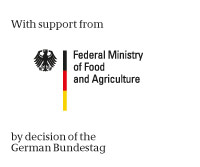Forest Education in Germany: a brief overview
After the large forest destructions after the Second World War biological communities of young people were founded that were led by foresters and teachers in Schleswig-Holstein, Lower Saxony and Hamburg. 1956 the “Jugendwaldring” was founded in Kiel and four years later, the different national associations joined the Federal Association of the German forest youth (Bundesverband Deutsche Waldjugend).
Tree planting and other practical measures as well as the emotional and sensual forest experience were and are the most important thing for the German forest youth. Pedagogically-oriented "forest education" increases since the nineties. The forest is now regarded as a learning object and as a starting point for further learning goals. The things kids learn in the forest shall be applied for sustainable development in local, regional and global contexts.
In particular, the proclamation of the UN Decade "Education for Sustainable Development" in 2005 has led to a veritable boom of offers of forest education in state forest administrations, universities and many private institutions. In 2002 the National Forest Administration of Baden-Württemberg created a forest educational learning center with the "house of the forest". To avoid country-specific individual paths in the forest education, the working group "Forest Environmental Education" of the “Bund Deutscher Forstleute” developed a uniform standard, which was confirmed by the Forestry Executive Conference (Forstchefkonferenz) in 2007. Certificate courses were implemented by the provincial forestry departments, where teachers, educators, foresters and other scientists were taught forest educational. At the universities Weihenstephan, Rottenburg, Göttingen, Munich and Erfurt forest-related environmental educational seminars were held. Since 2004 there is also a pan-European network for forest education, the "European network forestpedagogics / European Forestpedagogics", in which more than 1,300 experts from 41 European countries are connected.







